Marc Spector: Moon Knight - (1989-1994)
A year later in 1989, Moon Knight would again get his own series, this one being his longest run series to date. Unlike his other series, the naming structure would be different. It was called “Marc Spector: Moon Knight.” The first two years of this new series was written by Chuck Dixon. 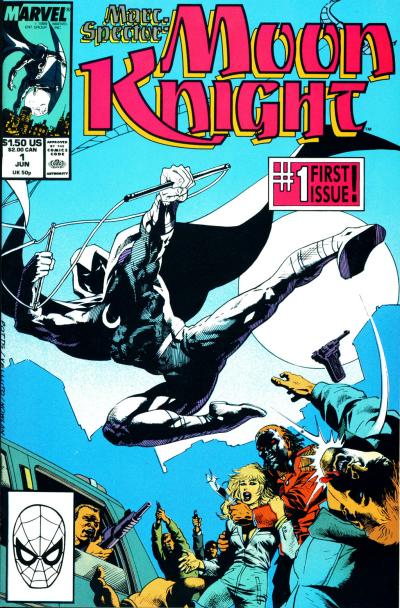 Interestingly, for the first seventeen issues, his credit was “Charles Dixon,” appearing as “Chuck” for the first time with #17.
Interestingly, for the first seventeen issues, his credit was “Charles Dixon,” appearing as “Chuck” for the first time with #17.
During his run, Dixon seemed to attempt to integrate Moon Knight more into the Marvel Universe proper, while retaining as much of his old attributes as possible. Right away in the series’ first three issues, his supporting cast of Marlene and Frenchie returned, as also his archnemesis of Bushman. Issue #4 brought the ongoing subplot of the new “Midnight Man” (this time a potential ally), but with issue #5 Dixon brought in other Marvel characters, such as the Black Cat, normally a supporting character to Spider-Man. With issues #6-7, Moon Knight again teamed-up with Brother Voodoo but integration with the shared nature of the Marvel Universe really kicked in with issues #8-10 in which Moon Knight found himself dragged into the Acts of Vengeance crossover. During the crossover event, Moon Knight had worked with the Punisher. After basically resolving the threat of the Bushman with #14, Dixon explored Marc Spector’s past with the 4-part “Trial of Marc Spector” storyline, running through #15-18, guest starring Silver Sable and her Wild Pack for good measure. Moon Knight would once again work with the Punisher in #19-21, during which Spider-Man also guest starred.
Although Chuck Dixon departed with #24, the writers that followed continued his integration of Moon Knight with the MU. The next nine issues were either written or co-written by Howard Mackie or JM DeMatteis. During this time, Moon Knight hosted guest stars such as the then very popular Danny Ketch Ghost Rider. After a 5-part story revisiting the character of semi-villain of Stained Glass Scarlett in #26-31, issues #32-33 saw Moon Knight face against the demonically-possessed Hobgoblin, who had recently been possessed during the Inferno storyline in the X-titles. The encounter would leave Marc Spector infected with a “demonic virus” via the Hobgolbin’s scratch, which would run as a subplot through the next year of stories.
Writer Terry Kavanagh took over with #35 and would write (and for two issues co-write) every issue until the series’ end with #60. Right away, Kavanagh sought to upend the status quo in the 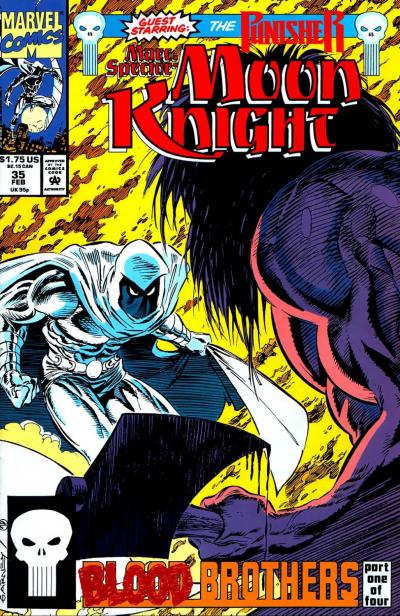 4-part “Blood Brothers” storyline in which the mansion of Marc Spector’s Steven Grant identity (which also served as Moon Knight’s base of operations) was destroyed. By the end of the story, Moon Knight had a new headquarters, composed of an entire city block of interconnected, rundown warehouses called the Shadowkeep, a new set of Adamantium weaponry and battle armor and a whole new network of informants he called his Shadow Cabinet. These new tools served Moon Knight well in #39-40 when a mission sent him to the Latverian embassy, where he faced Doctor Doom.
4-part “Blood Brothers” storyline in which the mansion of Marc Spector’s Steven Grant identity (which also served as Moon Knight’s base of operations) was destroyed. By the end of the story, Moon Knight had a new headquarters, composed of an entire city block of interconnected, rundown warehouses called the Shadowkeep, a new set of Adamantium weaponry and battle armor and a whole new network of informants he called his Shadow Cabinet. These new tools served Moon Knight well in #39-40 when a mission sent him to the Latverian embassy, where he faced Doctor Doom.
Although he had not been part of the Infinity Gauntlet event a few years before, issues #41-44 had the Marc Spector: Moon Knight title participate in the Infinity War crossover. During this story, Moon Knight faced against his doppelganger, Moon Shade. Issue #45-47 brought back the subplot of Marc Spector’s medical condition, introduced just before the Infinity War crossover. Learning that his body was deteriorating due to a demon virus introduced from a scratch from the demonic Hobgoblin from #32-33, he raced against the clock for a cure. Fortunately, Moon Knight was able to get the genetic material from the “Demogoblin” to provide him the antidote he needed. Kavanagh continued to pay homage to Moon Knight’s history. Although he had not been an Avenger for quite some time, Moon Knight found himself called before them with #50 to answer for misrepresenting himself as being on a mission for the Avengers during his recent adventure with Doctor Doom. Moon Knight replied by burning his Avengers membership card. Issues #52-53 brought another encounter with Jack Russell and his Werewolf by Night persona.
By this point, the sales for Marc Spector: Moon Knight had dipped to the point where it was near cancelation. Issue #55, however, brought a lot of attention and led to increased sales when newcomer artist Stephen Platt appeared out of nowhere, quickly gaining popularity and fame for his art. Platt’s art style drew quick comparisons to the art style of Todd McFarlane, something Platt  acknowledged with the cover of #57, which was a direct homage to previous McFarlane covers to Spider-Man. Platt only drew four issues (#55-57 & 60), which was not enough to save the book’s cancelation with #60. However, before he departed Moon Knight and Marvel altogether to draw a book at Image Comics called Prophet, Platt’s energy and style caused a few issues of Marc Spector: Moon Knight to be a very sought-after book.
acknowledged with the cover of #57, which was a direct homage to previous McFarlane covers to Spider-Man. Platt only drew four issues (#55-57 & 60), which was not enough to save the book’s cancelation with #60. However, before he departed Moon Knight and Marvel altogether to draw a book at Image Comics called Prophet, Platt’s energy and style caused a few issues of Marc Spector: Moon Knight to be a very sought-after book.
In the last five issues of the series, Kavanagh introduced a new villain in Seth the Immortal, who claimed to be an immortal ancestor of Marc Spector’s. During these last few stories, Kavanagh had Spector abandon his Shadow Cabinet organization and, after crossover with the then-current Infinity Crusade event, Moon Knight battled and defeated Seth and his allies, the Hellbent. However, even from beyond the grave Seth struck back, activating a series of explosives that destroyed Moon Knight’s Shadowkeep and ending the hero's life.
| Writers | Artists |
Special #1 - Doug Moench |
Special #1 - Art Nichols |
Moon Knight (3rd series) - (1998-1998)
 As with many comic characters, death was not the end. Four years later, Moon Knight’s original creator, Doug Moench, was given the opportunity to bring back his creation in a 4-issue miniseries. Logically, Moench used Spector’s patron deity of Khonshu as the “deus ex machina” of his divine resurrection and the few remaining issues of the series not only re-set the character’s “status quo,” but featured his “greatest hits.” Marc Spector was quickly reunited with Marlene and Frenchie (along with a cameo by Werewolf by Night for good measure). Moon Knight’s first mission was to thwart, once again, the threat of Morpheus, followed by a confrontation with Stained Glass Scarlet, Black Spectre and Bushman. By the end of the story, Moench had also reestablished the doubt with which he had portrayed Moon Knight in his first series, having Spector question both the existence of Khonshu and what was real.
As with many comic characters, death was not the end. Four years later, Moon Knight’s original creator, Doug Moench, was given the opportunity to bring back his creation in a 4-issue miniseries. Logically, Moench used Spector’s patron deity of Khonshu as the “deus ex machina” of his divine resurrection and the few remaining issues of the series not only re-set the character’s “status quo,” but featured his “greatest hits.” Marc Spector was quickly reunited with Marlene and Frenchie (along with a cameo by Werewolf by Night for good measure). Moon Knight’s first mission was to thwart, once again, the threat of Morpheus, followed by a confrontation with Stained Glass Scarlet, Black Spectre and Bushman. By the end of the story, Moench had also reestablished the doubt with which he had portrayed Moon Knight in his first series, having Spector question both the existence of Khonshu and what was real.
| Writers | Artists |
|---|---|
|
|
Moon Knight (4th series) – aka “High Strangers” - (1999-1999)
Moon Knight did not have to wait long for another series. A year later, Doug Moench had the opportunity to write another 4-issues miniseries. The storyline title, called “High Strangers,” 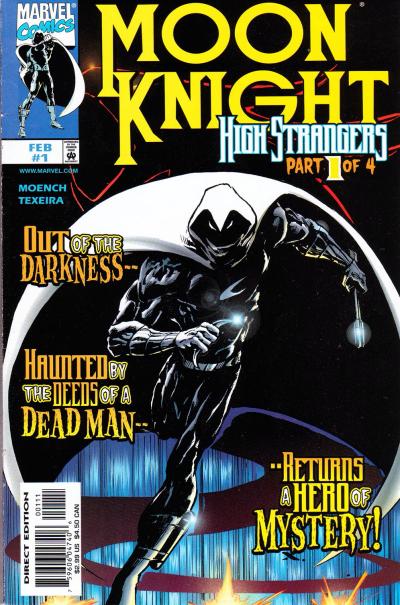 appeared prominently on the cover below the Moon Knight logo. As such, some consider this the name of the series, rather than simply being “Moon Knight.” However, the indicia in the first page clearly notes it as being “Moon Knight,” though it notes it as being “Vol 3.,” presumably not counting the “Fist of Khonshu” series. This series featured the art of Mark Texeira, whose grittier style evoked the art of Bill Sienkiewicz from the first Moon Knight series.
appeared prominently on the cover below the Moon Knight logo. As such, some consider this the name of the series, rather than simply being “Moon Knight.” However, the indicia in the first page clearly notes it as being “Moon Knight,” though it notes it as being “Vol 3.,” presumably not counting the “Fist of Khonshu” series. This series featured the art of Mark Texeira, whose grittier style evoked the art of Bill Sienkiewicz from the first Moon Knight series.
The four issues of this miniseries dealt with basically one story in which Moon Knight and his allies learned that the hero was the target of assassination from the Red Dragon Cult. Moon Knight eventually triumphed over the cult but, as always, began to doubt the veracity of what he experienced and what he believed he knows to be true. In a way, the tone of the series could be compared with the same themes as the then-ongoing and popular X-Files series, in which the main characters (and the viewers) were left to interpret what was real and what was not.
| Writers | Artists |
|---|---|
|
|
Marvel Knights (1st series) - (2000-2001)
The next title in which Moon Knight appeared was not his own. In addition to his ongoing series, in late 1999 Marvel gave Daredevil a second series, called “Marvel Knights.” This new title featured Daredevil and his ally Shang-Chi putting together an unofficial, street-level team comprised of himself, Black Widow and Dagger (of “Cloak and…”). In #4 of that series, Moon Knight comes to learn of Daredevil’s team and offered not only to join but finance it. Moon Knight participated in a few missions, but the storyline in #12-14 resulted in serious personal and financial setbacks for the character, leading to his departure.
| Writers | Artists |
|---|---|
|
|
Moon Knight (5th series) - (2006-2009)
When writer Charlie Huston was given the opportunity to write a new Moon Knight series five years later, it seemed that he wanted to deconstruct the character. He started “in medias res” with Marc Spector a broken man. Not only was he no longer Moon Knight, but he was alone and 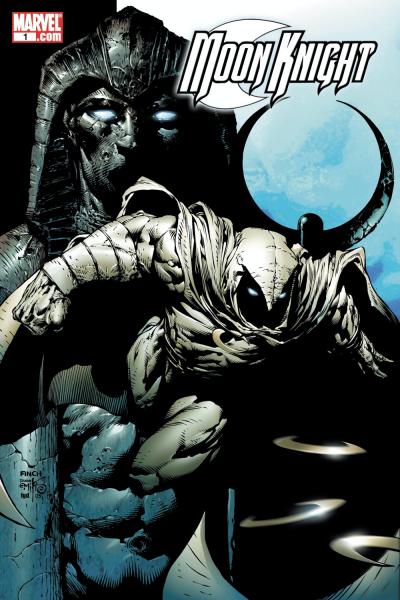 clearly abusing drugs and alcohol. Most of the events in the first issue, depicting his career as a hero and his personal life with Marlene, were all in his head. The issue ended with him first cursing Khonshu and then pleading to the god to let him be a hero again.
clearly abusing drugs and alcohol. Most of the events in the first issue, depicting his career as a hero and his personal life with Marlene, were all in his head. The issue ended with him first cursing Khonshu and then pleading to the god to let him be a hero again.
Over the next four issues, readers learned of how Marc Spector got to this point. How the children of the original Committee had sought revenge over the hero who had brought down their parents. They allied with a semi-precog named Profile and then hired Spector’s old nemesis Bushman to take him out. Although Bushman managed to crippled Moon Knight, the pain and horror of the situation drove the hero to madness, leading him to use a crescent dart to carve off Bushman’s face. As always, Frenchie and Marlene came to Marc Spector’s aid but it was too late for his sanity. Spector drove his friend and lover away, leading him down the path of self-pity and substance abuse. Huston also took an opportunity in #3 to offer a slight retcon of Frenchie, Spector’s longtime friend, ally and “Man Friday.” Already a man who doubted what he knew to be true, Marc learned that his old friend was gay and had been in love with him, something he had never even suspected.
With his character at his lowest with #3, Charlie Huston started the process to build him back up over the next three issues. The catalyst of him taking revenge over an attack on Frenchie awakened Spector’s will to live. It was at this moment that he was visited by Khonshu, though it was a new variation which readers had not seen before. This new Khonshu appeared to Spector in the form of Bushman, whose face was still skinned just as Marc had left him, and who now urged Moon Knight on with his most bloodthirsty rhetoric yet. Writer Huston had clearly demonstrated to readers that Marc Spector was severely delusional, so it was up to them as to whether they believed if this was really Khonshu or another manifestation of Spector’s psychosis. Whether this was really happening or all in his head, Spector found himself once again bestowed with Khonshu’s blessing and became his “fist.” In short order, Spector turned his life around. He adopted again the identity of Moon Knight and either through inner strength or divine gift, he defeated this new Committee. Likewise, a portion of his fortune was re-acquired, restoring his ability to finance his actions as a hero.
Huston’s second storyline dealt with the emergence of a new Midnight Man killer, which ran #7-12. Around this time, a new crossover event was running through the titles at Marvel with a story that 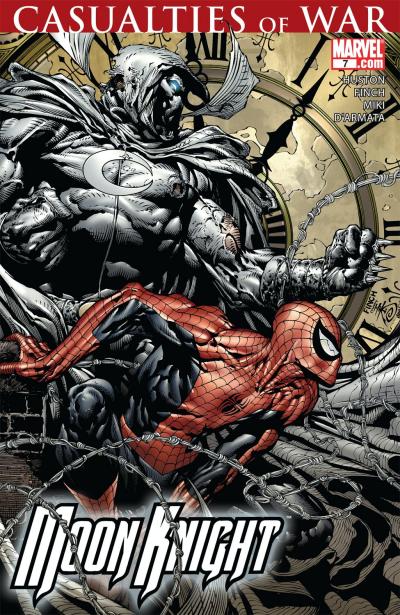 split both heroes and fans in two – Civil War. Although this storyline did not directly deal with the crossover event, the storyline and guest stars dealt with the ongoing argument of the legality and virtue of vigilantism and then veered into the Marvel’s “The Initiative” storyline, which dealt with the aftermath after the pro-Registration forces emerged as the winner.
split both heroes and fans in two – Civil War. Although this storyline did not directly deal with the crossover event, the storyline and guest stars dealt with the ongoing argument of the legality and virtue of vigilantism and then veered into the Marvel’s “The Initiative” storyline, which dealt with the aftermath after the pro-Registration forces emerged as the winner.
In #13, Marc Spector officially registered. So far in his run, Huston had steered more fully into the mental issues of Spector than any before him and he demonstrated this by depicting the absurdity of a government agency granting someone clearly insane the right to act an extra-legal crimefighter. The next main story arc ran from #14-19, during which Huston co-wrote with Mike Benson. This storyline dealt with the officially sanctioned Moon Knight getting more and more negative attention, first from the public and then from other heroes, over his violent tendencies. This story also brought back the character of Carson Knowles, the corrupt politician from Moon Knight’s first series, who had been arrested for his actions as the Black Spectre. Things came to a final head when Moon Knight killed the Black Spectre in a very public fashion.
Mike Benson took over writing completely with #20 and would stay with it during the remainder of the series run, which ended with #30. Despite his only recently returning to the moon god, Marc Spector again renounced Khonshu. Simultaneously, Moon Knight had cut ties with the Initiative, as he was now wanted for murder. Issues #21-25 dealt with Moon Knight evading capture, first from Tony Stark himself and then the Thunderbolts. Seeking refuge in his own mind, Spector abandoned his own identity and buried himself in the identity of Jake Lockley, who fled to Mexico. In the final story, running #26-30, Lockley became involved in a conflict with a Mexican drug lord. By the end of the story (and the series), he decided to return to New York as Moon Knight.
| Writers | Artists |
|---|---|
|
|
